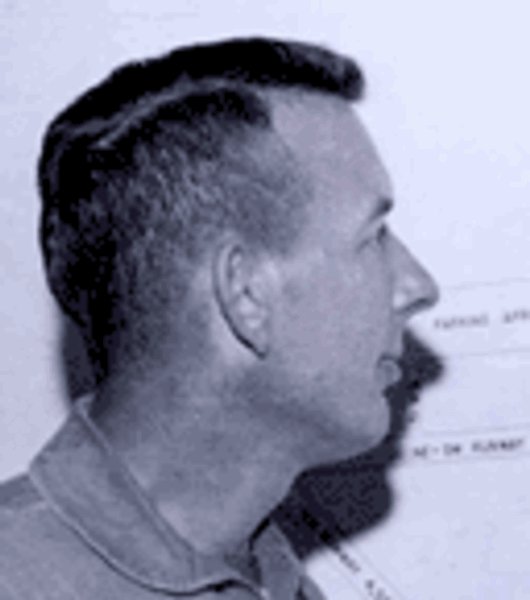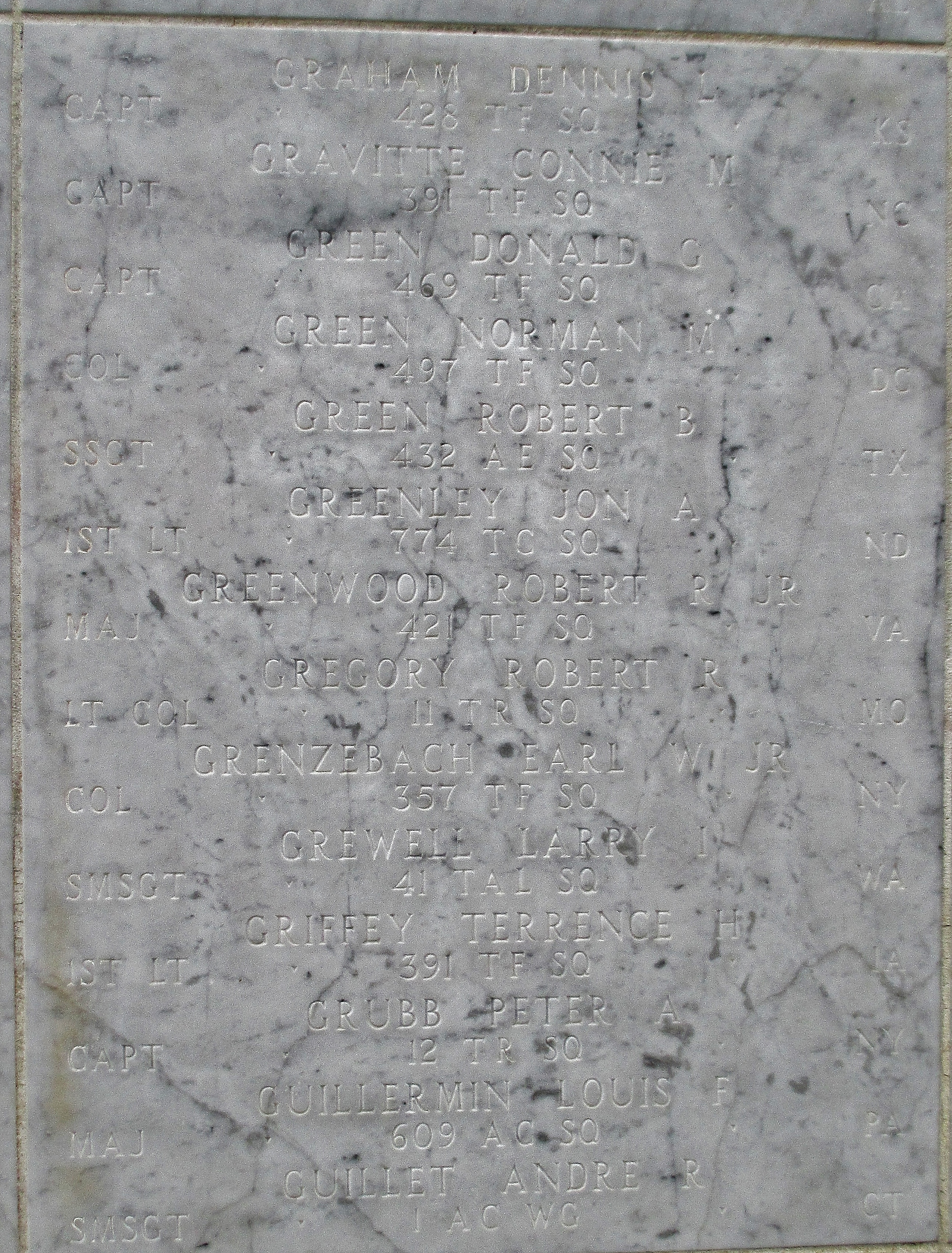Lieutenant Colonel, U.S. Air Force
11th Tactical Reconnaissance Squadron
Entered the Service From: Cape Giradeau, Missouri
Date of Birth: March 22, 1932
Date of Death: December 02, 1966
Wars or Conflicts: Vietnam War
Memorialized: Courts of the Missing: Court A
Honolulu Memorial
National Memorial Cemetery of the Pacific
Lieutenant Colonel Gregory was a member of the 11th Tactical Reconnaissance Squadron, Udorn Airbase, Thailand. On December 2, 1966, he was the pilot of a McDonnell Phantom II Reconnaissance Fighter (RF-4C) on a photo reconnaissance flight over Hanoi, North Vietnam. ** During the mission his aircraft was shot down. He ejected safely to the ground and was taken prisoner. He died in captivity and his remains were recovered on March 2, 1988 and identified on May 27, 1988. His name is inscribed on the Courts of the Missing at the Honolulu Memorial.
Lieutenant Colonel Robert Raymond Gregory's remains were recovered on March 02, 1988 and identified on May 27, 1988.
============
Robert Gregory was born to a poor family in Cape Girardeau,
Missouri, and had little time for the games of children. When "Greg" (or "Bobby") did act more like a youth, his idea of fun was sometimes a bit ambitious for his buddies.
"He liked to swim across the Mississippi River, rest and swim back," recalls a neighbor. "He was sort of a modern-day Huckleberry Finn." Another friend verifies the story and adds, "...he was kind of the leader of our group."
Gregory and a friend lied about their age to join the National Guard.
Despite lacking a college career behind him, Gregory ultimately achieved his goal of becoming an Air Force officer.
On leave in 1958, he eloped with Marjorie Fisher, a 14-year old girl from a large family in Bell City, Missouri. Marjorie followed Gregory to assignments in England and Germany. They had two children, and, as Marjorie says, "We were a pretty happy family. We had a lot of plans."
On December 2, 1966, Gregory and Stutz were assigned a 55 minute photo reconnaissance mission over Hanoi, North Vietnam. During a pass over their target, their aircraft was hit, and the two ejected as their aircraft crashed in the outskirts of Hanoi. After landing, the two established voice contact with each other, and both were captured.
Stutz said that he had seen Bob Gregory several times the day of their capture, but Gregory was unconsicous. Both men were transported to the Hoa Lo detention facility ("Hanoi Hilton") in Hanoi in the same truck and arrived on the same day they were shot down. Stutz never saw Gregory again.
Stutz' wife Karen and their young son waited for his return. Marjorie and
her son and daughter also waited. The Air Force showed Marjorie blurred,
blown-up photos they thought was her husband in captivity.
In March 1973, Leroy Stutz was released from Hanoi, one of almost 600 Americans who were freed at the time. Military experts expressed their dismay that "hundreds" thought to be prisoners were not released, and were named on no list provided by the Vietnamese. Reports soon began to flow into
the U.S. intelligence community relating to these men. A significant number of them indicated that Americans could still be alive in captivity.
Marjorie did the best she could with her life and her children. She never gave up hope that one day, her "doorbell would ring one of these days. He wouldn't mark me off if I were missing."
In 1987, Robert Gregory's photo and story was published in Life Magazine. By then, Gregory had been promoted to Lieutenant Colonel. The Kansas City Times ran an extensive article on Gregory and his family in late November 1987.
In both articles, Gregory was identified as a captive by his back-seater.
Just over 3 months later, the Vietnamese "discovered" the remains of LtCol. Robert R. Gregory and returned them to U.S. control. The pain that Marjorie and her children had experienced for 22 years could finally be laid to rest
with her husband. But the questions will never end. They may never how - or when - he died.
Lieutenant Colonel, U.S. Air Force
11th Tactical Reconnaissance Squadron
Entered the Service From: Cape Giradeau, Missouri
Date of Birth: March 22, 1932
Date of Death: December 02, 1966
Wars or Conflicts: Vietnam War
Memorialized: Courts of the Missing: Court A
Honolulu Memorial
National Memorial Cemetery of the Pacific
Lieutenant Colonel Gregory was a member of the 11th Tactical Reconnaissance Squadron, Udorn Airbase, Thailand. On December 2, 1966, he was the pilot of a McDonnell Phantom II Reconnaissance Fighter (RF-4C) on a photo reconnaissance flight over Hanoi, North Vietnam. ** During the mission his aircraft was shot down. He ejected safely to the ground and was taken prisoner. He died in captivity and his remains were recovered on March 2, 1988 and identified on May 27, 1988. His name is inscribed on the Courts of the Missing at the Honolulu Memorial.
Lieutenant Colonel Robert Raymond Gregory's remains were recovered on March 02, 1988 and identified on May 27, 1988.
============
Robert Gregory was born to a poor family in Cape Girardeau,
Missouri, and had little time for the games of children. When "Greg" (or "Bobby") did act more like a youth, his idea of fun was sometimes a bit ambitious for his buddies.
"He liked to swim across the Mississippi River, rest and swim back," recalls a neighbor. "He was sort of a modern-day Huckleberry Finn." Another friend verifies the story and adds, "...he was kind of the leader of our group."
Gregory and a friend lied about their age to join the National Guard.
Despite lacking a college career behind him, Gregory ultimately achieved his goal of becoming an Air Force officer.
On leave in 1958, he eloped with Marjorie Fisher, a 14-year old girl from a large family in Bell City, Missouri. Marjorie followed Gregory to assignments in England and Germany. They had two children, and, as Marjorie says, "We were a pretty happy family. We had a lot of plans."
On December 2, 1966, Gregory and Stutz were assigned a 55 minute photo reconnaissance mission over Hanoi, North Vietnam. During a pass over their target, their aircraft was hit, and the two ejected as their aircraft crashed in the outskirts of Hanoi. After landing, the two established voice contact with each other, and both were captured.
Stutz said that he had seen Bob Gregory several times the day of their capture, but Gregory was unconsicous. Both men were transported to the Hoa Lo detention facility ("Hanoi Hilton") in Hanoi in the same truck and arrived on the same day they were shot down. Stutz never saw Gregory again.
Stutz' wife Karen and their young son waited for his return. Marjorie and
her son and daughter also waited. The Air Force showed Marjorie blurred,
blown-up photos they thought was her husband in captivity.
In March 1973, Leroy Stutz was released from Hanoi, one of almost 600 Americans who were freed at the time. Military experts expressed their dismay that "hundreds" thought to be prisoners were not released, and were named on no list provided by the Vietnamese. Reports soon began to flow into
the U.S. intelligence community relating to these men. A significant number of them indicated that Americans could still be alive in captivity.
Marjorie did the best she could with her life and her children. She never gave up hope that one day, her "doorbell would ring one of these days. He wouldn't mark me off if I were missing."
In 1987, Robert Gregory's photo and story was published in Life Magazine. By then, Gregory had been promoted to Lieutenant Colonel. The Kansas City Times ran an extensive article on Gregory and his family in late November 1987.
In both articles, Gregory was identified as a captive by his back-seater.
Just over 3 months later, the Vietnamese "discovered" the remains of LtCol. Robert R. Gregory and returned them to U.S. control. The pain that Marjorie and her children had experienced for 22 years could finally be laid to rest
with her husband. But the questions will never end. They may never how - or when - he died.
Sponsored by Ancestry
Advertisement
Explore more
Sponsored by Ancestry
Advertisement




